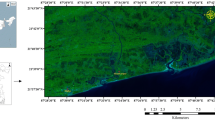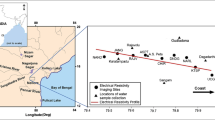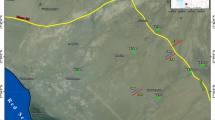Abstract
Seawater intrusion is recognised as a major factor affecting the quality of groundwater in coastal aquifers around the world. To determine the occurrence and extent of saline groundwater intrusion prevailing in the Heuningnes Catchment, a 2D resistivity imaging survey was carried out in three sites within the catchment. Eleven resistivity profile lines were conducted using the multi-electrode ABEM SAS resistivity meter system, employing the Wenner Array to map the extent of saline groundwater. A 2D resistivity image was acquired for these resistivity profile lines and the data were processed using Res2DINV software to produce the 2D inverse resistivity models. The interpretation of the resistivity models revealed three resistivity zones. The first zone is characterised by low resistivity (1–3 Ω.m); this represents an aquifer filled with saline water. The second resistivity zone has values ranging from (3–30 Ω.m); this represents a brackish saturated formation. The third resistivity zone denotes a sandy layer/sandstone saturated with freshwater having high resistivity values above 30 Ω.m. Geochemical analysis results of water samples at 11 locations along the electrical resistivity profile lines also suggest high salinity, indicated by high levels of Cl−, Na+, Total Dissolved Solids, and Electrical Conductivity. It is concluded that some parts of the study area are impacted by seawater intrusion, based on the lower resistivity of < 3 Ω.m and ionic ratios which were close to the standard seawater ratios for Na+/Cl− and SO42−/Cl−. In addition, the high ionic ratios of Na+/Cl− and SO42−/Cl− suggest that salinity in the area is a result of dissolution of evaporates and dilution of marine clays rich in sodium. Therefore, salinization in the study area is the result of combined processes. Integration approach proved to be significant in mapping saline groundwater in coastal aquifers. Integrated assessment of resistivity data, ionic analysis and chemical interpretation indicate that the study area is a transition zone from freshwater to saltwater and only few locations are actually impacted by seawater intrusion. The overall groundwater quality is not apt for human ingestion.












Similar content being viewed by others
References
Adepelumi AA, Ako BD, Ajayi TR, Afolabi O, Omotoso EJ (2009) Delineation of saltwater intrusion into the freshwater aquifer of Lekki Peninsula, Lagos. Nigeria Environ Ear Sci 56(5):927–933
Agoubi B, Kharroubi A, Abichou T, Abida H (2013) Hydrochemical and geoelectrical investigation of Marine Jeffara Aquifer, southeastern Tunisia. Appl Water Sci 3:415–429. https://doi.org/10.1007/s13201-013-0091-4
Alfarrah N, Walraevens K (2018) Groundwater Overexploitation and Seawater Intrusion in Coastal Areas of Arid and Semi-Arid Regions. Water Journal. https://doi.org/10.3390/w10020143
Bouderbala A, Remini B, Hamoudi AB (2016) Geoelectrical investigation of saline water intrusion into freshwater aquifers: a case study of Nador coastal aquifer, Tipaza, Algeria
Deshpande SM, Aher KR (2012) Evaluation of Groundwater Quality and its Suitability for Drinking and Agriculture use in Parts of Vaijapur, District Aurangabad, MS. India Res J Chem Sci 2(1):25–31
Dushiyanthan C, Raja J, Kumar T, Karthikeyan K, Raju D, Thiruneelakandan B, Suresh R (2014) Assessment of shallow Aquifer Potentialzone using ElectricalResistivity Scanning Techniques Compare with Borehole Lithology in We stern part of Lower Vellar basin, Chidambaram Taluk, Cuddalore, Tamilnadu, India. Int. Res. J Earth Sci 2(2), 30–34, March
Felisa G, Ciriello V, Di Federico V (2013) Saltwater Intrusion in Coastal Aquifers: A Primary Case Study along the Adriatic Coast Investigated within a Probabilistic Framework. Journal of water 5:1830–1847
Freeze RA, Cherry JA (1979) Groundwater. Prentice-Hall Inc., Englewood Cliffs, p 604.
Gaaloul N, Pliakas F, Kallioras A, Schuth C, Marinos P (2012) Simulation of Seawater Intrusion in Coastal Aquifers: Forty Five-Years Exploitation in an Eastern Coast Aquifer in NE Tunisia. J Hydrol 6:31–44
Hamdan H, Kritikakis G, Andronikidis N, Economou N, Manoutsoglou E, Vafidis A (2010) Integrated geophysical methods for imaging saline karst aquifers. A casestudy of Stylos, Chania, Greece. Journal of the Balkan Geophysical Society 13(1), p. 1–8, 6
Hazreek ZA, Hashim MMM, Asmawisham AM, Hafiz N, Fairus ZM, Fahmy YM, Ashraf KA, Rosli MI, Nordiana MM (2018) Seawater Intrusion Mapping using Electrical Resistivity Imaging (Eri) at Malaysian Coastal Area. Int J of Civil Eng Tech 9(9):1185–1193
Herdien EL, Petersen C, Reed C, Impson D, Belcher A, Ndiitwani T, Buthelezi S, Matoti A (2005) Technical Report: Ecological Status for Rivers of the Overberg Region 2004/2005 HilL and associates 2008. Situation assessment for Heuningnes Estuary. Report AGU07/596/02 pp1–36
Hodlur GK, Dhakate R, Sirisha T, Panaskar DB (2010) Resolution of freshwater and saline water aquifers by composite geophysical data analysis methods. Hydrol Sci J 55(3):414–434. https://doi.org/10.1080/02626661003738217
Johnson TA, Matsumoto N, Jansen JR (2008) Time Domain Electromagnetic Induction and High Resolution Electric Resistivity Soundings to Map Salt Water Intrusion in Coastal Sandy Aquifers, Los Angeles County, California. 20th Salt Water Intrusion Meeting June 23–27, Naples, Florida, USA.
Kanagaraj G, Elango L, Sridhar SGD, Gowrisankar G (2018) Hydrogeochemical processes and influence of seawater intrusion in coastal aquifers south of Chennai. Environ Sci Pollut Res, Tamil Nadu, India. https://doi.org/10.1007/s11356-017-0910-5
Kelly BB (2011) Using Electrical Resistivity Imaging to Map Saline Groundwater and Subaqueous Spring Discharge: An Example from the Saline Wetlands of Eastern Nebraska. Dissertation, University of Nebraska, pp161
Khan A, EghbalBakhtiari A (2017) Groundwater Assessment of Coastal Aquifers in Karachi: Impact of Seawater Intrusion. Int. J. of Ground Sediment and Water 6
Klassen J, Allen DM, Kirste D (2014) Chemical Indicators of saltwater intrusion for the gulf islands, British Columbia. Report, Simon Fraser University
Kumar PJS (2016) Deciphering the groundwater–saline water interaction in a complex coastal aquifer in South India using statistical and hydrochemical mixing models. Model Earth Syst Environ 2:194. https://doi.org/10.1007/s40808-016-0251-2
Lagudu S, Rao VVSG, Sarma VS, Prasad PR (2013) Use of Geophysical and Hydrochemical Tools to Investigate Seawater Intrusion in Coastal Alluvial Aquifer, Andhra Pradesh, India. https://doi.org/10.1007/978-94-007-5648-9_4
Lewis AL, Lautier JC, Wilson NC, Chianese G, Webb S (2004) Geophysical monitoring and evaluation of coastal plain aquifers. National groundwater association 42(1):59–67
Loke MH (1999) Electrical imaging surveys for environmental and engineering studies, user manual for Res2dinv Electronic version available from http://www.geometrics.com
MacQuarrie K, Butler K, Mott E, Green N (2012) A case study of coastal aquifers near Richibucto, New Brunswick: Saline groundwater occurrence and potential impacts of climate change on seawater intrusion. pp 1–18
Mallick J, Singh CK, AlMesfer MK, Kumar A, Khan RA, Islam S, Rahman A (2018) Hydro-Geochemical Assessment of Groundwater Quality in Aseer Region, Saudi Arabia Water journal, 10, 1847; https://doi.org/10.3390/w10121847
Mazvimavi D (2018) Finding “new” water to address conflicting and competing water demands in the Nuwejaars Catchment, Cape Agulhas. WRC report no 2324/1/18, pp135
Meyer PS (2001) An Explanation of the 1:500 000 General Hydrological Map of Cape Town
Mogren S (2015) Saltwater Intrusion in Jizan Coastal Zone, Southwest Saudi Arabia, Inferred from Geoelectric Resistivity Survey. Int J of Geosciences 6:286–297
Mohanty AK, Rao VVSG (2019) Hydrogeochemical, seawater intrusion and oxygen isotope studies on a coastal region in the Puri District of Odisha, India. CATENA 172:558–571. https://doi.org/10.1016/j.catena.2018.09.010
Mokoena P, Kanyerere T, van Bever DJ (2020) Hydrogeochemical characteristics and evaluation of groundwater quality for domestic and irrigation purposes: a case study of the Heuningnes Catchment, Western Cape Province. South Africa SN Applied Sciences 2:1548. https://doi.org/10.1007/s42452-020-03339-0
Mtoni Y (2013) Saltwater intrusion in the coastal strip of Dar es Salaam Quaternary aquifer, Tanzania. Dissertation, Ghent University, Faculty of Sciences, Belgium, 395 pp
Nair IS, Rajaveni SP, Schneider M, Elango L (2015) Geochemical and isotopic signatures for the identification of seawater intrusion in an alluvial aquifer. J Earth Syst Sci 124(6):1281–1291
Nwankwoala HO (2013) Ionic Abundance and Distributions in Groundwater Systems: A Case Study. Greener Journal of Physical Sciences 3(4):115–130
Ohwoghere- Asuma O, Akpoborie IA, Akpokodje EG (2014) Investigation of Saltwater Intrusion in Warri –Effurun Shallow Groundwater Aquifer from 2D Electrical Resistivity Imaging and Hydraulic Gradient Data. New York Science Journal 7(12): 20 29]. (ISSN: 1554–0200). http://www.sciencepub.net/newyork
Oyeyemi KD, Aizebeokhai AP, Oladunjoye MA (2015) Integrated Geophysical and Geochemical Investigations of Saline Water Intrusion in a Coastal Alluvial Terrain, South-western Nigeria. Int. J. Appl Envir Sci ISSN 0973–6077 10, (4), pp. 1275–1288
Papazotos P, Koumantakis I, Vasileiou E (2019) Hydrogeochemical assessment and suitability of groundwater in a typical Mediterranean coastal area: A case study of the Marathon basin, NE Attica. Greece HydroResearch 2(2019):49–59
Piper AM (1953) A graphical procedure in the geochemical interpretation of water analysis.
Transactions, American Geophysical Union 25 914–923
Prasanna MV, Chidambaram S, Gireesh TV, Jabir Ali TV (2010) A study on Hydrochemical characteristics of Surface and Sub-surface water in and around Perumal Lake, Cuddalore District, Tamilnadu. South India Environmental Earth Sciences (In Press). https://doi.org/10.1007/s12665-010-0664-6
Rajaveni SP, Brindha K, Elango L (2017) Geological and geomorphological controls on groundwater occurrence in a hard rock region. Appl Water Sci 7:1377–1389. https://doi.org/10.1007/s13201-015-0327-6
Rao VVSG, Rao GT, Surinaidu L, Rajesh R, Mahesh J (2011) Geophysical and Geochemical Approach for Seawater Intrusion Assessment in the Godavari Delta Basin, A.P. India Water Air Soil Pollution 217:503–514
Ravindran AA, Ramanujam N, Sudarsan R (2013) Delineation of Saltwater and Freshwater Interphase in Beach Groundwater Study Using 2D ERI Technique in the Northern Sector of the Gulf of Mannar Coast, Tamilnadu. Water journal p 1–11
Russell IA and Impson ND (2006) Aquatic systems in and adjacent to Agulhas National Park with particular reference to the fish fauna. Koedoe 49(2): 45–57. Pretoria. ISSN 0075 6458
Sae-Ju J, Chotpantarat S, ThitimakornT, (2018) Assessment 1 of seawater intrusion using multivariate statistical, hydrochemical and geophysical techniques in coastal aquifer, Cha-am district, Thailand. Hydrol Earth Syst Sci Discuss. https://doi.org/10.5194/hess-2018-137
Salman SA, Elnazer AA (2015) Evaluation of groundwater quality and its suitability fordrinking and agricultural uses in SW Qena Governorate. Egypt Adv in Nat Appl Sci 9(5):16–26
Satriani A, Loperte A, Imbrenda V, Lapenna V (2012) Geoelectrical surveys for characterization of the coastal saltwater intrusion in metapontum forest reserve (Southern Italy). Int J Geophys 2012. https://doi.org/10.1155/2012/238478
Song S, Lee G, Kim J, Seong B, Kim Y, Woo M, Park N (2006) Electrical Resistivity Survey for Delineating Seawater Intrusion in a Coastal Aquifer.pp.289–294
Supriyadi K, Putro AAP (2017) Geophysical and hydrochemical approach for seawater intrusion in North Semarang, Central Java. Indonesia Int J GEOMATE 12(31):134–140
Toens PD, Visser D, Van Der Westhuizen CR, Stadler W, Rasmussen JM (1998) Overberg Coastal Water Resources (Volume II): A Report to DWAF on the Groundwater Resources, Current and Future Water Requirements of the Coastal Strip and Adjoining Hinterland between the Potberg and Quoin Point, T and P, Toens and Partners, Cape Town, February
Wen Y, Qiu J, Cheng S (2020) Xu C and Gao X (2020) Hydrochemical Evolution Mechanisms of Shallow Groundwater and Its Quality Assessment in the Estuarine Coastal Zone: A Case Study of Qidong, China. Int J Environ Res Public Health 17:3382. https://doi.org/10.3390/ijerph17103382
WHO (2011) Hardness in Drinking-water: Background document for development of WHO Guidelines for Drinking-water Quality, 11p
Xu Y, Lin L, Jia H (2009) Groundwater Flow Conceptualization and Storage Determination of the Table Mountain Group (TMG) Aquifers
Yusof NF, Mohamed Zawawi MA, Juahir H, Karim NZ (2016) Application of Geophysical Technique in Investigation of Groundwater Quality at Melaka Tengah, Malacca. J. Adv. Res Des 2462–1943 24 (1). Pages 1–12
Zaghlool E, Eissa M (2018) Integrated Geochemical Indicators and Geostatistics to Asses Processes Governing Groundwater Quality in Principal Aquifers, South Sinai. Egypt Middle East J Appl Sci 8(3):939–956
Weight WD (2008) Hydrogeology field manual, 2nd edn. McGraw-Hill Companies Inc, New York, USA
Acknowledgements
The authors of this paper would like to acknowledge the following people for their great assistance in this study M de Klerk, Environmental Water Science research team and Water Research Commission (WRC) for funding the study.
Author information
Authors and Affiliations
Contributions
PM was responsible for drafting of the article, conception and design, acquisition, analysis and interpretation of data, JvBD and TK were responsible for reviewing, revising and for the final approval of the article, KM was responsible for acquisition and reviewing of data.
Corresponding author
Ethics declarations
Conflict of interest
The authors would like to declare no conflict of interest.
Additional information
Publisher's Note
Springer Nature remains neutral with regard to jurisdictional claims in published maps and institutional affiliations.
Rights and permissions
About this article
Cite this article
Mokoena, P., Manyama, K., van Bever Donker, J. et al. Investigation of groundwater salinity using geophysical and geochemical approaches: heuningnes catchment coastal aquifer. Western Cape Province, South Africa. Environ Earth Sci 80, 191 (2021). https://doi.org/10.1007/s12665-021-09507-8
Received:
Accepted:
Published:
DOI: https://doi.org/10.1007/s12665-021-09507-8




